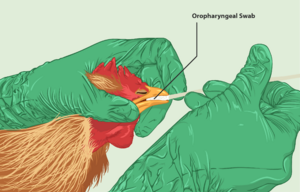Bird flu facts for kids
Bird flu (also known as avian influenza or avian flu) is an illness caused by a virus. This virus, called influenza A, usually lives in birds. However, it can sometimes infect mammals, including humans. When it infects humans, we call it influenza, or simply "the flu."
There are many different types of influenza A viruses. The first one was found in a bird in Italy way back in 1878. Most types cause mild symptoms, like breathing problems, similar to a common cold.
But some types of bird flu can be very dangerous. They can kill birds, and a few types have even killed humans and other mammals. For example, a type of bird flu known as Spanish flu caused a huge outbreak in 1918-1920, killing between 50 and 100 million people worldwide. Later, the Asian Flu in 1957 and the Hong Kong Flu in 1968 each killed about one million people.
A specific type, called H5N1, caused a serious outbreak in Hong Kong in 1997, killing six people. It appeared again in China in 2003. By mid-2005, H5N1 was mostly found in Southeast Asia. Since then, it has spread to parts of Africa and Europe. This virus has killed tens of millions of birds. To stop its spread, hundreds of millions of other birds have had to be put down. So far, H5N1 is mostly a bird disease and rarely infects humans.
Scientists are very concerned about H5N1 because it changes very quickly. There's a worry it could change into a type that spreads easily among humans, causing a worldwide flu outbreak (a pandemic) that could kill many millions of people. Governments around the world are spending a lot of money to prepare for this. They are studying H5N1, creating vaccines, practicing how to respond to a pandemic, and storing important flu medications.
How to Prevent Bird Flu
People who don't often come into contact with birds usually have a low risk of getting bird flu. However, some people are at higher risk. This includes workers on poultry farms, animal control workers, and scientists who study birds.
If you work with birds, it's important to have a plan to prevent the spread of bird flu. Farms should keep their birds separate from wild birds and their waste. Vehicles used on farms should be cleaned regularly and not shared between different farms.
Protecting Yourself
Using the right safety gear helps a lot to prevent infection. It's important to protect your eyes, nose, mouth, and hands. These are the most common ways the virus can enter your body.
Proper safety gear includes:
- Aprons or coveralls
- Gloves
- Boots or boot covers
- A head or hair cover
It's best to use disposable gear when possible. Special masks called N-95 respirators and safety goggles are also important. Some people might use a powered air purifying respirator (PAPR) with a hood or face shield for extra protection.
Reporting Cases
If someone gets sick after working with infected birds, reporting it quickly can help stop the spread. In the US, the Centers for Disease Control and Prevention suggests that if a worker shows symptoms within 10 days of contact with infected poultry, they should see a doctor. They should also tell their employer, who then needs to inform public health officials.
Images for kids
See also
 In Spanish: Gripe aviaria para niños
In Spanish: Gripe aviaria para niños



